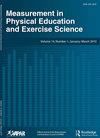Long Jump, Vertical Jump, and Vertical Jump Power Reference Curves for 10-18 Year Olds
IF 1.9
4区 教育学
Q2 EDUCATION & EDUCATIONAL RESEARCH
Measurement in Physical Education and Exercise Science
Pub Date : 2022-01-05
DOI:10.1080/1091367X.2021.2017291
引用次数: 3
Abstract
ABSTRACT We developed age- and sex-specific smoothed percentiles for vertical and long jump, as well as vertical jump power, in healthy 10–18 year olds (n = 529, 47.1% female). Jump height and distance were measured and vertical jump power was assessed via mechanography. LMS regression was used to create smoothed age-specific reference curves, separated by sex. Pearson correlations between the jumps ranged from r = 0.22 to 0.64, varying by age and sex. Comparing medians, younger males had slightly higher values for vertical and long jump compared to females. Vertical jump power was more comparable between the sexes. For all measures, differences between the sexes become more pronounced at ages associated with the transition into adolescence. Growth model coefficients are reported for calculation of Z-scores. The growth curves can be used to compare samples, track lower body power, and link tests of fitness to athletic performance or health-related outcomes.10-18岁儿童跳远、垂直跳和垂直跳力量参考曲线
摘要:我们为10-18岁的健康青少年(n=529,47.1%为女性)制定了针对年龄和性别的垂直和跳远以及垂直跳跃力的平滑百分位数。测量跳跃高度和距离,并通过力学成像评估垂直跳跃力。LMS回归用于创建按性别划分的平滑年龄特异性参考曲线。跳跃之间的Pearson相关性在0.22-0.64之间,因年龄和性别而异。比较中位数,与女性相比,年轻男性的垂直和跳远值略高。垂直跳跃能力在两性之间更具可比性。从所有的衡量标准来看,在进入青春期的年龄段,性别之间的差异变得更加明显。报告增长模型系数用于计算Z分数。生长曲线可用于比较样本,跟踪下半身力量,并将体能测试与运动表现或健康相关结果联系起来。
本文章由计算机程序翻译,如有差异,请以英文原文为准。
求助全文
约1分钟内获得全文
求助全文
来源期刊

Measurement in Physical Education and Exercise Science
Medicine-Orthopedics and Sports Medicine
CiteScore
4.20
自引率
33.30%
发文量
24
期刊介绍:
The scope of Measurement in Physical Education and Exercise Science (MPEES) covers original measurement research, special issues, and tutorials within six substantive disciplines of physical education and exercise science. Six of the seven sections of MPEES define the substantive disciplines within the purview of the original research to be published in the journal: Exercise Science, Physical Activity, Physical Education Pedagogy, Psychology, Research Methodology and Statistics, and Sport Management and Administration. The seventh section of MPEES, Tutorial and Teacher’s Toolbox, serves to provide an outlet for review and/or didactic manuscripts to be published in the journal. Special issues provide an avenue for a coherent set of manuscripts (e.g., four to five) to collectively focus in-depth on an important and timely measurement-related issue within the scope of MPEES. The primary aim of MPEES is to publish high-impact manuscripts, most of which will focus on original research, that fit within the scope of the journal.
 求助内容:
求助内容: 应助结果提醒方式:
应助结果提醒方式:


